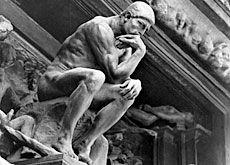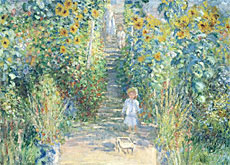Gates to Hell open in Zurich

It contains 186 figures and stands 6.80-metres high – the Gates of Hell, inspired by Dante's Divine Comedy, is one of French sculptor Auguste Rodin's greatest works.
Zurich’s Kunsthaus fine arts museum is lucky enough to own a copy. Recently restored, the monumental work is at the heart of an exhibition devoted to the 19th century master.
Visitors coming to the Kunsthaus have long been able to see the Gates to Hell outside the building. The sculpture, one of eight casts, came to Zurich in 1947.
The unfinished piece – Rodin continued working on it throughout his life – features tragic characters and damned souls, but is not without erotic touches as well.
The French master’s famous sculpture The Kiss was originally modelled for the Gates. The Thinker, which represents Dante, whom the artist greatly admired, was also a part of the work.
All three pieces can be seen in a new Rodin exhibition set up in collaboration with the Musée Rodin in Paris and London’s Royal Academy of Arts.
“The Royal Academy hosted the exhibition first, so we had the Gates of Hell shipped to London and they stood in front of the Royal Academy – splendidly renovated – for three months before coming back,” Christoph Becker, curator of exhibition and director of the Kunsthaus, told swissinfo.
“We are now hosting an exhibition of 160 works of Auguste Rodin throughout his lifetime and through all periods of his creation – whatever he did is here, including all the masterpieces.”
Modern
The display, which includes works in bronze and plaster, as well as sketches, makes judicious use of the modern, spacious setting at the Kunsthaus. Daylight is favoured over artificial lighting
It is somewhat different to the grander environment of the Royal Academy.
“It’s very exciting to see the display under beautiful daylight and in a space which is so open with different views,” Catherine Lampert, co-curator of the London exhibition, told swissinfo.
“Rodin always changes under the physical circumstances and in this case it’s a very happy change.”
The Frenchman revolutionised sculpture. He was one of the first artists to make fragmentation – such as the headless Walking Man – into an artistic principle.
He favoured natural poses, showing bones, muscles and nerves very prominently, and also had an eye for light and shade.
Astonishment
His works resulted in much astonishment, and not a little consternation, when they were first exhibited in 1889 in Paris.
They were rather different to the prevailing classical style. There were no plinths and the “choppy” surfaces of his figures raised some eyebrows.
“Rodin is a figure between the 19th century and modernism,” explained Becker. “He’s both an artist fully aware of the tradition of sculpting and the tradition of human figure in sculpture.”
“He did a lot of experiments on sculpture which have led to modern art and have had an impact on contemporary artists today.”
Other exhibition highlights include 4.5-ton The Burghers of Calais, featuring six figures, and a sculpture of French author Victor Hugo.
Scandals
Visitors can also see The Age of Bronze, a work that caused scandal in its day as it was wrongly thought to have been cast from a living subject.
Rodin’s colourful private life can also be glimpsed.
A bust based on his faithful companion Rose Beuret – whom he finally married when she was 73, two weeks before her death in 1917 – is presented, as are statues modelled on his various mistresses, including Camille Claudel, a gifted artist in her own right.
Claudel and Rodin had a passionate personal and professional relationship in the 1880s and 1890s, during which they inspired and influenced each other’s work.
Photos of Rodin’s works, commissioned by the artist himself – he was legendary for his need for recognition – are also on display.
But despite this longstanding artistic legacy, Lampert says it is hard to know Rodin completely.
“He left so many models, work in different stages and 7,000 drawings. It’s a very rich archive but he was also a complicated and exciting artist.”
swissinfo, Isobel Leybold-Johnson in Zurich
The exhibition runs from February 9 to May 13, 2007.
It contains 160 bronzes, works in plaster and drawings in 1,300 sq metres of space.
It includes lesser-known works such as The Earth and The Moon.
Gates of Hell can be seen in its usual place outside the museum. Pieces of the work are also on display inside the exhibition.
The French sculptor was born in 1840 and came from a humble background.
He was rejected by the prestigious art school Ecole des Beaux-Arts three times and originally made his living as a sculptor’s assistant.
Rodin’s work was first recognised in the 1880s and was considered groundbreaking for its strength and realism.
The Gates of Hell was commissioned in 1880 for a museum in Paris, and remained unfinished at his death. It resulted in two of Rodin’s most famous images: The Thinker and The Kiss.
Rodin died in 1917, the same year married his faithful companion Rose Beuret. They had one son.

In compliance with the JTI standards
More: SWI swissinfo.ch certified by the Journalism Trust Initiative











You can find an overview of ongoing debates with our journalists here . Please join us!
If you want to start a conversation about a topic raised in this article or want to report factual errors, email us at english@swissinfo.ch.